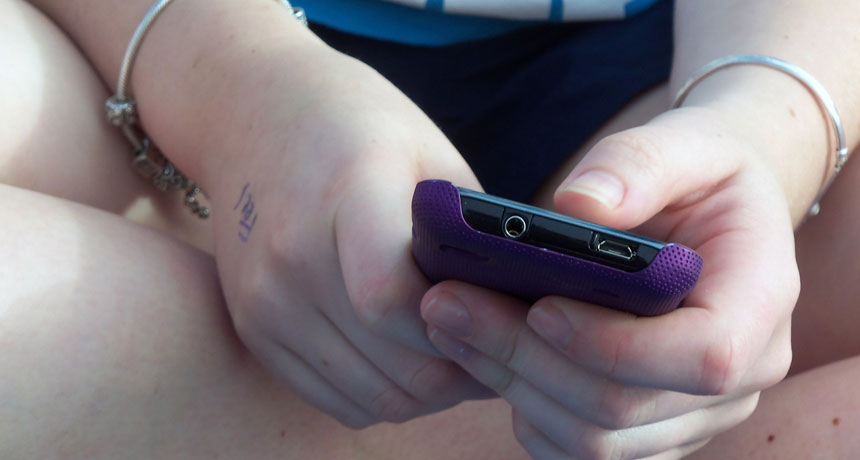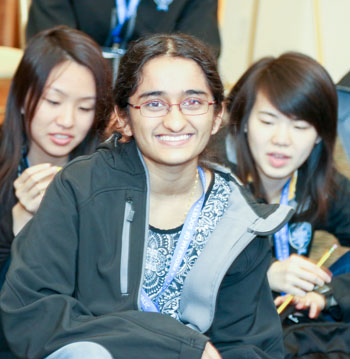How you handle your smartphone could become a secure ID
A smartphone may one day recognize its owner by the way it’s been picked up

The way people pick up their phones is specific only to them, a teen shows.
Summer Skyes 11/Flickr (CC-BY 2.0)
Share this:
- Share via email (Opens in new window) Email
- Click to share on Facebook (Opens in new window) Facebook
- Click to share on X (Opens in new window) X
- Click to share on Pinterest (Opens in new window) Pinterest
- Click to share on Reddit (Opens in new window) Reddit
- Share to Google Classroom (Opens in new window) Google Classroom
- Click to print (Opens in new window) Print
WASHINGTON, D.C. — Is your smartphone locked? To unlock it, you might have to enter a passcode or press your finger to a sensor. But what if your phone knew who you were — just by the way you lifted it? Yashaswini Makaram, 17, has found that the way each of us moves is specific to us — and very hard for others to mimic.
The senior at the Massachusetts Academy of Math and Science in Worcester brought her results to the Intel Science Talent Search. It brings 40 high school seniors here each year to share their projects with the public and compete for awards totally more than $1 million. The competition is run by Society for Science & the Public, which publishes this blog, and sponsored by Intel Corp.
“The thing about motion is that it’s habitual,” Yashaswini says. “You do the motion over and over and it becomes ingrained. You do it the same way.” That includes large movements, such as the way a person walks or runs, as well as small ones, like picking up a phone. “No one will move quite like you do,” she says.
Most modern smartphones have an accelerometer built into them. This sensor measures vibrations and changes in the how fast the phone (and the person holding it) moves. An accelerometer is what your phone uses to track how many steps you take in a day, for example.
Many smartphones also have a gyroscope — a device that measures the orientation of something in space. This is how the phone “knows” that someone has turned it sideways — and then adjusts its screen accordingly.

She placed the phone with the apps carefully on a square drawn on a piece of paper. Then, Yashaswini gathered 20 students from her science class. With the apps running on the phone, she had each student scoop up the phone 10 times. Each participant was recorded on video as they picked up the phone. That way Yashaswini could analyze their movements.
The teen used all of these data to come up with a movement signature for each person. It was a unique combination of angles and speeds that they used when picking up a phone. She then wrote a computer program to identify who lifted the phone solely based on those signature movement. The program could identify the “owner” of the phone 85 percent of the time.
Yashaswini’s program also could tell when someone was trying to fool it. The teen had 10 of her subjects imitate the movements of another. But no matter how hard they tried, her program caught them 93 percent of the time.
The teen’s app isn’t available yet. It’s still just a proof of concept, she explains. It merely shows that it’s possible to identify people by the way they lift their phone. But she hopes someday her method could be used to keep phones safe from prying fingers. It’s all in the way they move.
Follow Eureka! Lab on Twitter
Power Words
(for more about Power Words, click here)
acceleration A change in the speed or direction of some object.
accelerometer An instrument for measuring vibrations or a change in the rate of movement. These sensors typically can measure movement changes in all three dimensions (front-to-back, side-to-side and up-and-down).
app Short for application, or a computer program designed for a specific task.
application A particular use or function of something.
gyroscope A device to measure the 3-dimensional orientation of something in space. Mechanical forms of the device tend to use a spinning wheel or disc that allows one axle inside it to take on any orientation.
Intel Science Talent Search An annual competition created and run by Society for Science & the Public and sponsored by Intel Corp. Begun in 1950, this event brings 40 research-oriented high school seniors to Washington, D.C. to showcase their research to the public and to compete for awards.
sensor A device that picks up information on physical or chemical conditions — such as temperature, barometric pressure, salinity, humidity, pH, light intensity or radiation — and stores or broadcasts that information. Scientists and engineers often rely on sensors to inform them of conditions that may change over time or that exist far from where a researcher can measure them directly. (in biology) The structure that an organism uses to sense attributes of its environment, such as heat, winds, chemicals, moisture, trauma or an attack by predators.
smartphone A cell (or mobile) phone that can perform a host of functions, including search for information on the Internet.
Society for Science and the Public (orSSP) A nonprofit organization created in 1921 and based in Washington, D.C. Since its founding, SSP has been not only promoting public engagement in scientific research but also the public understanding of science. It created and continues to run three renowned science competitions: The Intel Science Talent Search (begun in 1942), the Intel International Science and Engineering Fair (initially launched in 1950) and Broadcom MASTERS (created in 2010). SSP also publishes award-winning journalism: in Science News (launched in 1922) and Science News for Students (created in 2003). Those magazines also host a series of blogs (including Eureka! Lab).